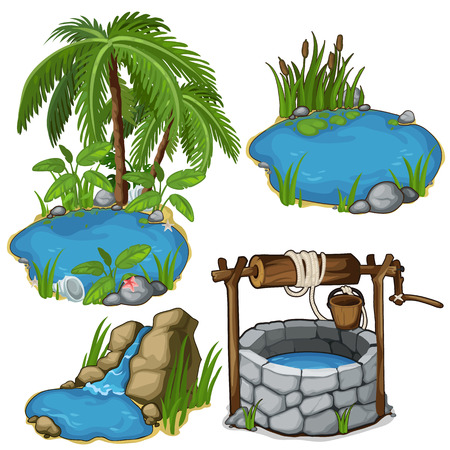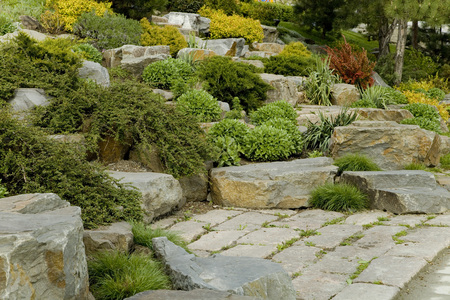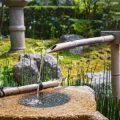1. Understanding U.S. Climate Zones
Before you start designing your rock garden, it’s important to understand the USDA Hardiness Zones. These zones divide the United States into regions based on average annual minimum winter temperatures. Knowing your zone helps you pick plants that will survive and thrive in your local climate.
What Are USDA Hardiness Zones?
The USDA Plant Hardiness Zone Map is a standard used by gardeners and growers to determine which plants are most likely to do well at a specific location. The map divides North America into 13 zones, each representing a 10°F difference in the average minimum temperature.
Why It Matters for Rock Gardens
Rock gardens often feature drought-tolerant or alpine plants, many of which are sensitive to extreme cold or heat. Choosing plants suited to your zone ensures they won’t just survive—they’ll flourish. Additionally, some zones may have higher humidity, rainfall, or soil challenges that affect plant selection and garden layout.
Quick Guide: Matching Plants to USDA Zones
| USDA Zone | Temperature Range (°F) | Recommended Rock Garden Plants |
|---|---|---|
| 3-4 (Northern Plains, Upper Midwest) | -40 to -20 | Creeping Phlox, Alpine Aster, Saxifrage |
| 5-6 (Northeast, Pacific Northwest) | -20 to 0 | Sedum, Dianthus, Hens and Chicks |
| 7-8 (Mid-Atlantic, South) | 0 to 20 | Lavender, Yucca, Ice Plant |
| 9-10 (Southern California, Florida) | 20 to 40 | Agave, Aloe, Euphorbia |
| 11+ (South Florida, Hawaii) | Above 40 | Tropical Succulents, Bromeliads |
Design Considerations by Zone
Your zone also influences design factors like drainage and sun exposure. For example:
- Cold climates: Focus on excellent drainage and south-facing slopes to maximize sunlight.
- Hot/dry climates: Incorporate shade from rocks or structures and choose heat-tolerant plants.
- Humid areas: Ensure good air circulation and use moisture-resistant rock types like granite.
Pro Tip:
If youre unsure of your USDA zone, you can find it by entering your ZIP code on the official USDA website or using gardening apps that offer zone lookup features.
Understanding your climate zone is the first step toward building a rock garden that not only looks great but also lasts through all seasons in your area.
2. Choosing the Right Location and Materials
Creating a rock garden that thrives in any U.S. climate zone starts with picking the right spot in your yard and using materials that work with nature, not against it. Whether you live in the arid Southwest or the humid Southeast, proper drainage and sunlight are key to success.
Finding the Ideal Location
Start by observing your yard throughout the day. Look for areas that receive plenty of sun—most rock garden plants prefer full sun (at least 6 hours of direct light). However, if youre working in a hotter region like Arizona or Nevada, some afternoon shade can help protect delicate plants from scorching.
Drainage is another big factor. Avoid low-lying spots where water tends to collect after rainstorms. A slight slope is ideal because it naturally encourages water to run off rather than pool around plant roots.
Sunlight and Drainage Guide by Region
| U.S. Climate Zone | Sunlight Needs | Drainage Tips |
|---|---|---|
| Northeast & Midwest | Full Sun to Partial Shade | Add gravel or sand to improve heavy clay soil |
| Southeast | Full Sun | Elevate beds to prevent root rot in humid conditions |
| Southwest & West | Full Sun with Afternoon Shade | Select native rocks to reflect heat and aid drainage |
| Pacific Northwest | Partial Sun | Create mounds or raised areas for better runoff |
Selecting Rocks That Work with Nature
The rocks you choose will define the look and function of your garden. Go for natural stone that blends with your local landscape. In drier regions, sandstone or lava rock fits right in. In wetter climates, granite or river rock stands up well to moisture.
Popular Rock Types by Region
- Granite: Durable and widely available; great for most zones.
- Limestone: Ideal for alkaline soil regions like Texas and parts of the Midwest.
- Lava Rock: Lightweight and porous; excellent for desert climates.
- Sandstone: Warms quickly; perfect for sunny spots in dry zones.
- River Rock: Smooth texture; good choice for adding visual contrast and aiding drainage.
The Importance of Soil Amendments
Your soil may need a little help to support drought-tolerant plants common in rock gardens. In most cases, mixing in coarse sand, pea gravel, or crushed granite will improve drainage and prevent soggy roots.
Simple Soil Mix for Well-Draining Beds:
- 1 part native soil
- 1 part coarse sand or crushed granite
- 1 part organic compost (optional for added nutrients)
This mix helps replicate the rocky, fast-draining environments many rock garden plants love—no matter which climate zone you call home.

3. Climate-Appropriate Plant Selection
Selecting the right plants is essential to creating a rock garden that not only looks beautiful but also thrives in your specific climate zone. The United States has a wide range of USDA hardiness zones, from the cold winters of Zone 3 to the hot and arid conditions of Zone 10 and beyond. Choosing resilient, drought-tolerant, and native plant species helps ensure long-term success with minimal maintenance.
Understanding Your USDA Hardiness Zone
Before selecting plants, its important to know your USDA hardiness zone. This zone map divides the U.S. into regions based on average minimum winter temperatures. You can find your zone by entering your zip code on the USDA Plant Hardiness Zone Map website.
Top Rock Garden Plants by U.S. Climate Zone
Heres a breakdown of recommended plant species for different USDA zones. These plants are known for their ability to thrive in rock gardens while handling local weather conditions:
| USDA Zone | Recommended Plants | Key Features |
|---|---|---|
| Zone 3-4 (Cold Climates) | Creeping Phlox, Alpine Aster, Sedum, Hens-and-Chicks | Cold-hardy, low-growing, excellent ground cover |
| Zone 5-6 (Cool Temperate) | Lamb’s Ear, Russian Sage, Coreopsis, Dianthus | Drought-tolerant, attracts pollinators |
| Zone 7-8 (Mild Winters) | Lavender, Yucca, Ice Plant, Black-eyed Susan | Tolerates heat and dry spells; colorful blooms |
| Zone 9-10+ (Hot & Arid) | Agave, Aloe Vera, Red Yucca, Desert Marigold | Highly drought-resistant; ideal for xeriscaping |
Why Native Plants Matter
Incorporating native plants into your rock garden offers many benefits. They are naturally adapted to your local environment, require less water and fertilizer, and provide habitat for beneficial insects and birds. For example:
- California Poppy (Eschscholzia californica): Ideal for western zones like CA; thrives in dry soil.
- Purple Coneflower (Echinacea purpurea): Suited for Midwest zones; attracts pollinators.
- Blue Grama Grass (Bouteloua gracilis): Excellent for dry plains and Southwest zones.
Drought-Tolerant Favorites for All Zones
If youre looking for universally tough plants that can handle less water across many zones, consider these options:
- Sedum (Stonecrop): Available in many varieties; survives extreme heat and cold.
- Thyme (Creeping Thyme): Low-maintenance groundcover with fragrant leaves.
- Euphorbia (Spurge): Unique texture and color; very drought-resistant.
Pro Tip:
Group plants with similar water and sunlight needs together to simplify care and make your rock garden more sustainable over time.
A carefully chosen mix of climate-appropriate plants will not only enhance the visual appeal of your rock garden but also reduce the need for constant upkeep. Whether youre dealing with frost or desert heat, theres a perfect plant selection waiting to bring your rock garden to life.
4. Design Principles for a Low-Maintenance Rock Garden
Creating a rock garden that looks great and requires minimal upkeep starts with smart design. Whether youre working with a small urban space or a sprawling backyard, focusing on layout, focal points, and layering can help you build a garden that thrives across all U.S. climate zones.
Plan Your Layout Wisely
Start by observing your space — notice sun exposure, slope, and natural drainage. Rock gardens work best when they mimic nature. Think of how rocks are scattered on a hillside or nestled in desert terrain. Use this inspiration to place rocks in natural-looking clusters rather than lining them up evenly.
Tips for Effective Layout:
- Group in odd numbers: Place rocks and plants in groups of three or five for a more organic look.
- Leave open space: Don’t overcrowd; negative space adds balance and allows room for growth.
- Use curves: Curved lines feel more natural than straight edges.
Create Eye-Catching Focal Points
A focal point draws the eye and gives your garden structure. This could be a large boulder, a striking drought-tolerant plant like agave, or even a sculptural piece of driftwood.
| Focal Point Idea | Description |
|---|---|
| Statement Boulder | A large rock with unique shape or color placed off-center in the garden |
| Sculptural Plant | Plants like yucca or red hot poker add height and drama |
| Garden Art | Metal sculptures or ceramic pots can enhance personality |
Master the Art of Layering
Layering creates depth and visual interest while helping your rock garden function well in all climates. Mix heights, textures, and colors to keep things dynamic throughout the year.
Layering Tips:
- Tall in back, short in front: Use taller grasses or shrubs at the back or center (depending on viewing angle), and ground covers near edges.
- Mix textures: Combine spiky plants like sedum with soft mounds of moss or thyme for contrast.
- Add seasonal variety: Choose plants that bloom at different times so there’s always something interesting going on.
By using these design principles—thoughtful layout, strong focal points, and strategic layering—you’ll create a rock garden that’s not only beautiful but also easy to maintain no matter where you live in the U.S.
5. Seasonal Care and Long-Term Maintenance
To keep your rock garden looking its best throughout the year, its important to follow a seasonal care routine that works for your specific U.S. climate zone. Here’s how you can stay on top of watering, weeding, and protecting your plants through every season.
Watering Schedules by Climate Zone
Rock gardens are known for their low-maintenance appeal, but that doesn’t mean they’re completely hands-off—especially when it comes to watering. The frequency and amount of water will depend on your local climate and the types of plants youve chosen.
| USDA Climate Zone | Watering Frequency (Spring–Fall) | Winter Watering Tips |
|---|---|---|
| Zones 3–5 (Cold) | 1x per week during dry spells | Avoid watering if ground is frozen; water evergreens monthly if no snow cover |
| Zones 6–7 (Temperate) | 1–2x per week depending on rainfall | Water occasionally during dry winters |
| Zones 8–10 (Warm) | 2–3x per week in summer; less in spring/fall | Irrigate monthly if winter is dry and warm |
| Zone 11+ (Tropical/Subtropical) | Regular deep watering as needed | No winter watering adjustments needed |
Weeding Strategies That Save Time
No matter where you live, weeds can sneak into your rock garden. Heres how to manage them with minimal effort:
- Add mulch or gravel: A thick layer of decorative gravel or stone mulch helps suppress weeds while keeping the look clean.
- Hand-pull regularly: Weeding once a week prevents roots from establishing deeply.
- Avoid tilling: Disturbing the soil brings dormant weed seeds to the surface.
- Drought-tolerant ground covers: Use low-growing plants like creeping thyme or sedum to crowd out weeds naturally.
Winter Protection Tips for Every Zone
Your rock garden needs different levels of protection depending on how cold your winters get. Heres what to consider before the first frost hits:
For Cold Zones (3–5)
- Add a thick layer of mulch around plant bases to protect roots from freeze-thaw cycles.
- Avoid cutting back foliage too early—dried stems can insulate crowns.
- If using containers, move them to sheltered areas or indoors if possible.
For Temperate Zones (6–7)
- Certain succulents may need light cover (like frost cloth) during unexpected cold snaps.
- Avoid overwatering in fall; soggy soil increases risk of root rot when temperatures drop.
For Warm and Tropical Zones (8–11+)
- You may not need winter protection, but watch for unseasonal cold fronts and cover sensitive plants accordingly.
- This is a good time to prune or divide overgrown plants as theyre less stressed by heat.
The Importance of Regular Check-Ins
A thriving rock garden isn’t just about setup—it’s about small, consistent efforts. Walk through your garden weekly to check for pests, signs of stress, or other issues. These short check-ins help you catch problems early and keep your garden looking great all year round.
Your Rock Garden Year-Round Checklist:
- Spring: Prune dead growth, divide crowded plants, refresh mulch/gravel layers.
- Summer: Monitor watering needs closely; watch for heat stress.
- Fall: Cut back selectively, reduce watering, prepare protective coverings if needed.
- Winter: Protect vulnerable plants; avoid unnecessary disturbance; water sparingly if conditions are dry and above freezing.
A little seasonal attention goes a long way in keeping your rock garden beautiful across all U.S. climate zones!


